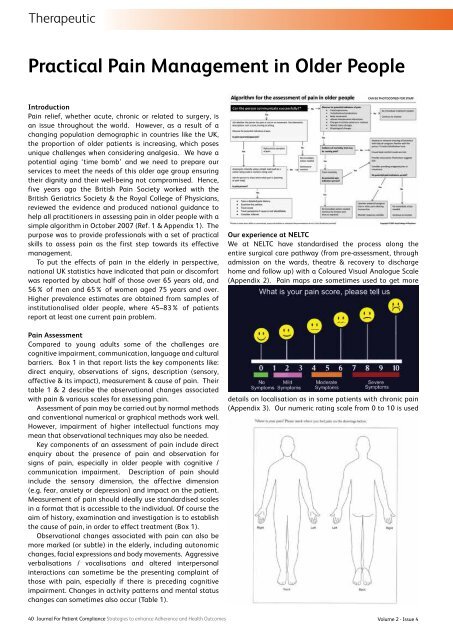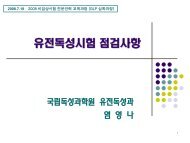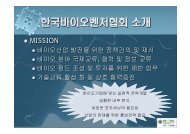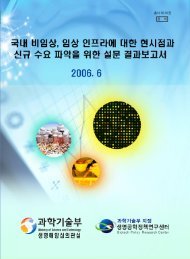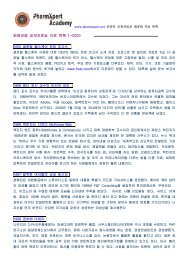TherapeuticPractical Pain Management in Older PeopleIntroductionPain relief, whether acute, chronic or related to surgery, isan issue throughout the world. However, as a result of achanging population demographic in countries like the UK,the proportion of older patients is increasing, which posesunique challenges when considering analgesia. We have apotential aging ‘time bomb’ and we need to prepare ourservices to meet the needs of this older age group ensuringtheir dignity and their well-being not compromised. Hence,five years ago the British Pain Society worked with theBritish Geriatrics Society & the Royal College of Physicians,reviewed the evidence and produced national guidance tohelp all practitioners in assessing pain in older people with asimple algorithm in October 2007 (Ref. 1 & Appendix 1). Thepurpose was to provide professionals with a set of practicalskills to assess pain as the first step towards its effectivemanagement.To put the effects of pain in the elderly in perspective,national UK statistics have indicated that pain or discomfortwas reported by about half of those over 65 years old, and56% of men and 65% of women aged 75 years and over.Higher prevalence estimates are obtained from samples ofinstitutionalised older people, where 45–83% of patientsreport at least one current pain problem.Pain AssessmentCompared to young adults some of the challenges arecognitive impairment, communication, language and culturalbarriers. Box 1 in that report lists the key components like:direct enquiry, observations of signs, description (sensory,affective & its impact), measurement & cause of pain. Theirtable 1 & 2 describe the observational changes associatedwith pain & various scales for assessing pain.Assessment of pain may be carried out by normal methodsand conventional numerical or graphical methods work well.However, impairment of higher intellectual functions maymean that observational techniques may also be needed.Key components of an assessment of pain include directenquiry about the presence of pain and observation forsigns of pain, especially in older people with cognitive /communication impairment. Description of pain shouldinclude the sensory dimension, the affective dimension(e.g. fear, anxiety or depression) and impact on the patient.Measurement of pain should ideally use standardised scalesin a format that is accessible to the individual. Of course theaim of history, examination and investigation is to establishthe cause of pain, in order to effect treatment (Box 1).Observational changes associated with pain can also bemore marked (or subtle) in the elderly, including autonomicchanges, facial expressions and body movements. Aggressiveverbalisations / vocalisations and altered interpersonalinteractions can sometime be the presenting complaint ofthose with pain, especially if there is preceding cognitiveimpairment. Changes in activity patterns and mental statuschanges can sometimes also occur (Table 1).Our experience at NELTCWe at NELTC have standardised the process along theentire surgical care pathway (from pre-assessment, throughadmission on the wards, theatre & recovery to dischargehome and follow up) with a Coloured Visual Analogue Scale(Appendix 2). Pain maps are sometimes used to get moredetails on localisation as in some patients with chronic pain(Appendix 3). Our numeric rating scale from 0 to 10 is used40 Journal For Patient Compliance Strategies to enhance Adherence and Health OutcomesVolume 2 - Issue 4
Therapeuticin those patients, with some difficulties, who are able to useverbal descriptor 0 to 5 scale by converting it to 0 to 10 whilerecording it (Appendix 4). We found this standardisation tobe very helpful in doing our routine recording of pain scoresby our nurses on the wards, and also in the Pain & SicknessAudit carried out by us based on their records. This auditshowed us excellent pain & sickness scores, with a highpatient satisfaction rate, compared to world literature & waspresented at various conferences in Birmingham (BAPIO),Wembley (BAOIA), Tel Aviv (ISA), Mumbai (ISA) & Granada(WSPC) and well received by the audience 2 . We followedthe recommendations of the National Guidelines whichare summarised (Appendix 5) along with the algorithm(Appendix 1).Management of Acute Postoperative PainThree years ago European Society of Regional Anaesthesiaand Pain Therapy produced general recommendations andprinciples for successful pain management postoperatively 3 .Effective pain management is a very important part ofmodern surgical practice. The goals are to: improve quality oflife, rapid recovery & early discharge with minimum morbidity.Listening to and believing in patient is the first step. Useof one scale within a hospital ensures that everyone in theteam ‘speaks the same language’ of intensity of pain, frompre-assessments, wards, recovery to discharge time. This alsohelps in adjusting drugs for better pain management 4 .Informed consent ensures detailed discussion about painand its treatment. To keep realistic expectations of carepatient participation is important and they need to knowabout ‘pain relief’, not a ’pain free status’. In addition toverbal information wall posters in the clinics / wards andpatient leaflets are useful.As the mechanism of pain is multi-factorial these daysmultimodal analgesia is recommended for a balancedcombination of analgesics, co-analgesics & local anaesthetic(LA) blocks or infiltrations. Surgeons routinely use localanaesthetics before or after (preferably both), with or withoutother form of anaesthesia to improve pain control. Using LAbefore incision means patient’s analgesic requirements &side-effects are reduced, especially in those older patientswith multiple co-morbidities.The elderly present special problems in the provisionof analgesia. As a general rule, the elderly report pain lessfrequently and require smaller doses of analgesic drugs toachieve adequate pain relief. Many patients are anxious,which may be associated with increased pain postoperatively.Commonest drugs in use are Paracetamol, NSAIDs,Gabapentin / Pregabalin, Codeine, Tramadol, Oxycodone,Morphine in various combinations, through a step by stepapproach depending on the severity of pain & patient’stolerance / intolerance of drugs. Drug dose for each drugprescribed needs to be tailored to patient requirementsespecially taking their age and age-related metabolic changesin consideration. Coxib or NSAIDs are used with caution inolder people usually with proton pump inhibitor and routinelymonitored for drug interactions, gastrointestinal, renal &cardiovascular side effects.NSAIDs (e.g. diclofenac, ibuprofen and naproxen areamongst the most widely used medications globally foranalgesia, particularly in patients with rheumatologicalconditions, but they can have serious side effects. Uppergastrointestinal disorders ranging from heartburn anddyspepsia are more common to peptic ulceration andgastrointestinal bleeding. Care should also be taken in patientswith compromised hepatic or renal function. These drugs canalso cause raised blood pressure, as well as leading to heartfailure and myocardial infarction in high-risk patients, firstdetected in studies of selective cyclo-oxygenase inhibitors.Self-medication with opioids is not always wise in elderlypatients and thus the role of patient-controlled analgesia maybe limited. The elderly may be particularly sensitive to opioidsand side effects such as confusion, sedation and respiratorydepression assume greater importance. Because of changes inhepatic and renal function lower doses of opioids are neededand the expected length of action may be longer.Only one analgesic drug should be used at a time in theelderly. In general about half the normal adult dose, evenless in very old, should be given at first, especially if the drugis being given intravenously. Small doses should be givenregularly to anticipate pain where appropriate.www.JforPC.comJournal For Patient Compliance Strategies to enhance Adherence and Health Outcomes 41


